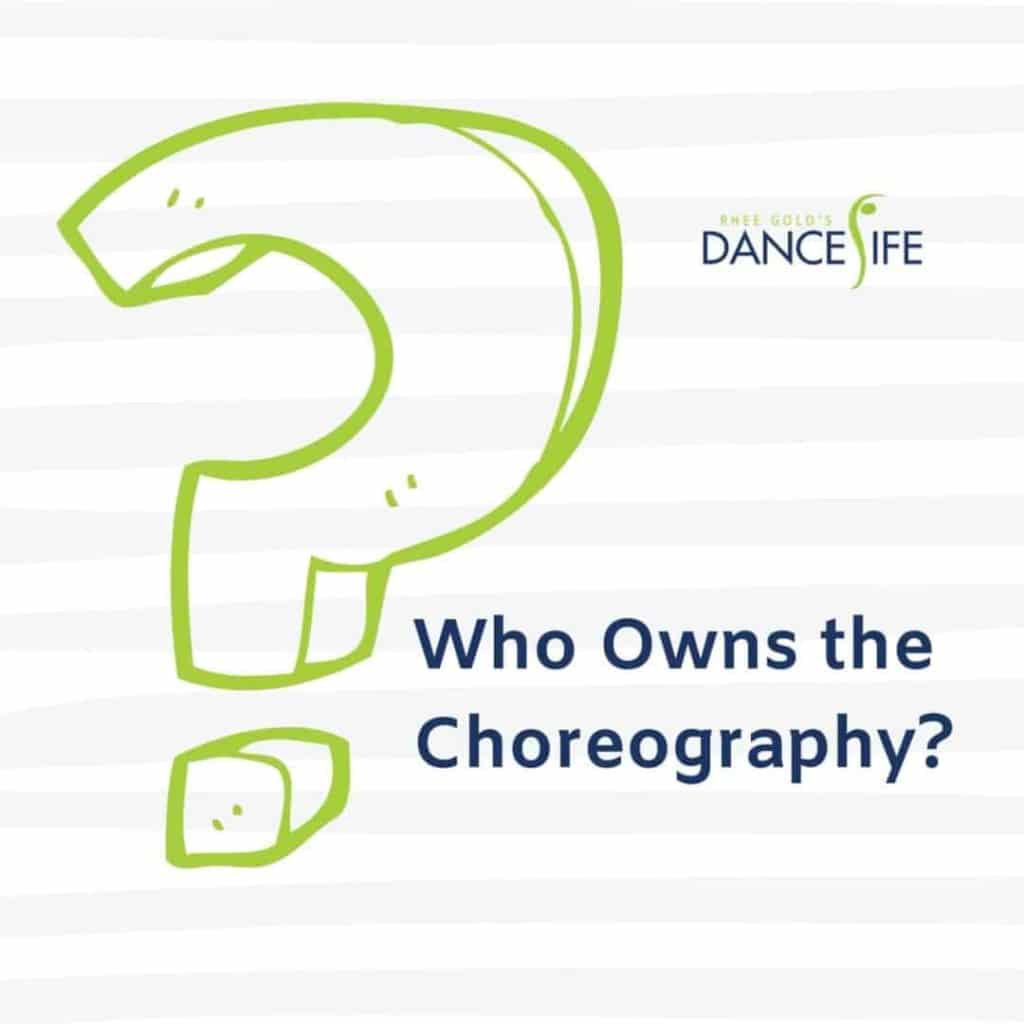Who Owns the Choreography?

Hi Rhee,
I have an interesting question for you. I am a former studio owner, now teaching again for others. Just yesterday the studio owner of one of the studios I teach at called and informed me that, due to financial reasons, she can no longer keep me on. I’m not an employee (she 1099’s me) but also I do not have a formal contract. Believe it or not, that’s not my question! I am the person who has taught all the comp pieces – I taught the classes and did the choreography. She intends on still bringing these dances to competition, has said she will give me full credit. But, I feel the choreography is mine and I don’t wish it used anymore. I am not there to see to it that the choreography is done correctly, etc., and don’t feel she should profit from this. Besides the obvious lesson learned for the future (!), do you know who is right in this? Can she use this choreography because she paid me to teach the classes? Or does the choreography belong to me?
~ Anonymous
Hello Anonymous,
Sorry you have to deal with this circumstance, but this is a good topic for discussion. My opinion is that a teacher is hired by the hour. If in that hour it is verbally or contractually agreed that part of the job description includes choreography for a performance, recital or competition, then the school owns the right to utilize the choreography . . . unless otherwise specified in an initial agreement or contract.
With that said, the choreographer (teacher) should always receive credit for her work . . . if she wants it :-).
Contracts which include a job description, choreography rights, etc. should be on the top of your priority list when you agree to teach somewhere else. Let this one go as a learning experience . . . a new door will open quickly and it will be a better one. Good luck—Rhee






This is an unfortunate situation and may feel like a slap in the face after all your work and it being mid-season and all; however, you were hired for a job and you did it. In the dance world, that includes providing your knowledge and artistry- which is now in the hands of the company that paid you for it. But in my opinion, it would be highly unethical if your name was not presented on these pieces. You certainly deserve credit for them.
I’m sure your students are very grateful for what you provided for them. Just be proud of all your hard work and move on to bigger and better things. Best of luck to you! 🙂
This question brings up additional questions for me, a studio owener. I am in the process of expanding my company and would like to have additional staff. Do you recommend the 1099 or going through the employee process. I would really appreciate your complete honesty.
I have had a lot of advice about the situation.. “if the teacher makes less than a certain amount..”
Teachers would work 2-4 hours a week for a 16 week period of time at about $15/class.
Thank you!
An article on sub-contractors/employees here at Dance Studio Life
https://rheegold.com/2009/07/whats-in-a-title/
A response emailed to me about this post–Rhee
Interestingly enough, I’ve found some other information pertaining to this subject, and I’ve spoken with an attorney. This subject falls under a section of the law known as Intellectual Property Rights. Itellectual Property Right laws have come to focus over the past few years due to Websites – and the copyright situations that come up with those. Choreography is also included under this. There is a lot of grey area and there, as a general rule, are not hard fast answers. My situation, due to all the complications, can only be solved in a court of law. Neither of us can claim rights to the choreography unless we take the other to court. Have no idea how this will play out in the end but I will keep you posted! However, I have to mention that, if a person is hired just to do choreography, and their only responsibility is to choreography a piece or show and set it on the dancers then the choreography belongs to the studio, with credit given to the choreographer. The grey area comes in when a person is hired to teach classes, with choreography being an assumed part of the process.
For studio owners, you are protected if the person has employee status.. If you go the Independent Contractor route you’d better have a contract that spells out any and all expectations or you will have to go to court for a decision of who owns the choreography. For teachers, in the event of a break in employment, if you don’t want your choreography used by the studio then you need to have that in a contract.
Again, some interesting information!
Thanks!
I know that in literature there is a copyright process one can use to protect one’s creative work. For example, the author of an article can copyright the article, then grant permission for it to be re-printed in a magazine. In this instance, the author is the owner of the copyrighted material. If an author writes an article for a magazine but does not have it copyrighted prior to releasing it to the magazine, then the magazine owns the copyright to the article as part of the copyright of the magazine. I have never spoken with an attorney about choreography, but this thought process is telling me that short of a contract outlining choreography ownership/rights within a studio teaching scenario, there may be a way for independent contract teachers to copyright their work prior to teaching it at a studio. Just something more to think about. Bk
I am sorry to hear that someone has to go through this and I understand were you are coming from. My question to you would be “what about the kids?”. I have been teaching for several years and I teach at different studios. I also had a similiar situation where I had to leave before the comp season. The routines were finished but not perfected. When I left I also asked that the routines not be used. After speaking to a close friend I relized that that would really hurt the kids. They had worked very hard and they should not be punished because of a situation that is out of their hands. Just thought this would be something to think about.
Great site with very informative posts. I have bookmarked this site for future reference.
The first question is whether you have “fixed” your choreography in any “tangible medium of expression.” That’s copyright-speak for asking whether you’ve recorded the choreography in a way that a dance teacher or choreographer could use to recreate the steps just by looking at what you’ve recorded. A common way to do that is via a video or, less commonly, via a choreographic notation system. Until your choreography is “fixed” in that “tangible medium” it is not protected at all by copyright. Once it is, it’s protected automatically, though there are substantial benefits to registering that copyright with the Copyright Office.
Let’s assume you have recorded your choreography in a form so that it is protected by copyright.
Under the Copyright Act, you are generally considered to be the owner of the copyright to your original choreography. The question is whether your status as an independent contractor entitles the studio to continue to use your choreography even without your permission.
There are exceptions to the general rule that the creator is the owner of the copyright. One is if the creator was an employee and created the choreography in the scope of her employment. That does not seem to apply in this case, since you were an independent contractor.
The other exception is if the choreography can be considered a “work made for hire” under the Copyright Act. That’s a deceptive term. It does not mean simply that if you were hired to choreograph a piece that the studio owns the piece. Here is what can be considered to be a “work made for hire”:
a work specially ordered or commissioned for use as a contribution to a
collective work, as a part of a motion picture or other audiovisual work, as
a translation, as a supplementary work, as a compilation, as an instructional
text, as a test, as answer material for a test, or as an atlas,
And here is an important condition that applies to all of the above:
if the parties expressly agree in a written instrument signed by them that the work shall be considered a work made for hire.
In this case, it does not appear that the choreography you created falls under any of the “work made for hire” categories. Further, it does not sound as though there was any written agreement between you and the studio owner about the ownership of the copyright. So it would seem that — assuming you have a copyright to protect — that you may have a reasonably strong argument that you still own that copyright.
The studio may have a counterargument, however — that it has an implied license to use the choreography at least for the current ‘season.’ Your counterargument to that could be that any such license was conditioned on the studio continuing to pay you through the season. As you can see, things could get a bit messy.
This may seem counterintuitive, but it has tripped up many business owners. A common example is when a business hires a website developer to create a website for the business. If the agreement does not assign over the copyright from the developer to the business, then the business does not own the copyright to the website.
From your perspective, as a teacher/choreographer, it may benefit you to have a written contract that addresses these sorts of issues. But just to return to the beginning, the first step is to make sure that the choreography is recorded somewhere in a way that will be usable by someone else.
It seems really talented writers who are willing to share a very good article online.
Thanks very much for your help